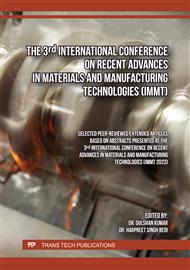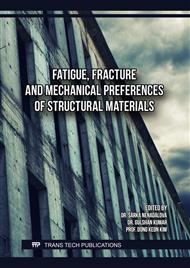p.3
p.11
p.19
p.29
p.39
p.51
p.61
p.67
Bending Fatigue Strength of WAAM Ultra-High-Strength Steel
Abstract:
This study investigates the bending fatigue strength of ultra-high-strength steel (UHS) steel manufactured using wire arc additive manufacturing (WAAM) technology. Hardness evaluations, conducted in the built direction, demonstrated a remarkable consistency with an average hardness of approximately 292 HV throughout the entire deposited component. Further hardness measurements across printed layers revealed uniformity, indicating a lack of hardness variation within the interlayer region. Macrostructural analysis revealed fine grains characterized by an equiaxed morphology, showcasing a distinctive crystallographic arrangement. This microstructural configuration plays a pivotal role in shaping the mechanical behavior and properties of the material. While a detailed microstructure study was not conducted, the macro-level investigation confirmed the absence of visible pores or defects in the printed material, affirming its structural integrity and resilience. Tensile tests conducted on samples extracted from the WAAM part unveiled anisotropic behavior, with tensile strength in the built direction approximately 35 MPa higher than that in the deposition direction. The maximum yield strength reached an impressive 846 MPa in the built direction. Although the yield strength of WAAM UHS was lower compared to the yield strength promised by the welding wire manufacturer, the differing heat input in the WAAM process accounted for this variation. Fatigue strength of the WAAM UHS steel was significantly better compared to WAAM carbon steel used as reference material. The WAAM UHS sample exhibited a robust fatigue limit of 350 MPa.
Info:
Periodical:
Pages:
19-25
Citation:
Online since:
May 2025
Authors:
Price:
Сopyright:
© 2025 Trans Tech Publications Ltd. All Rights Reserved
Share:
Citation:



